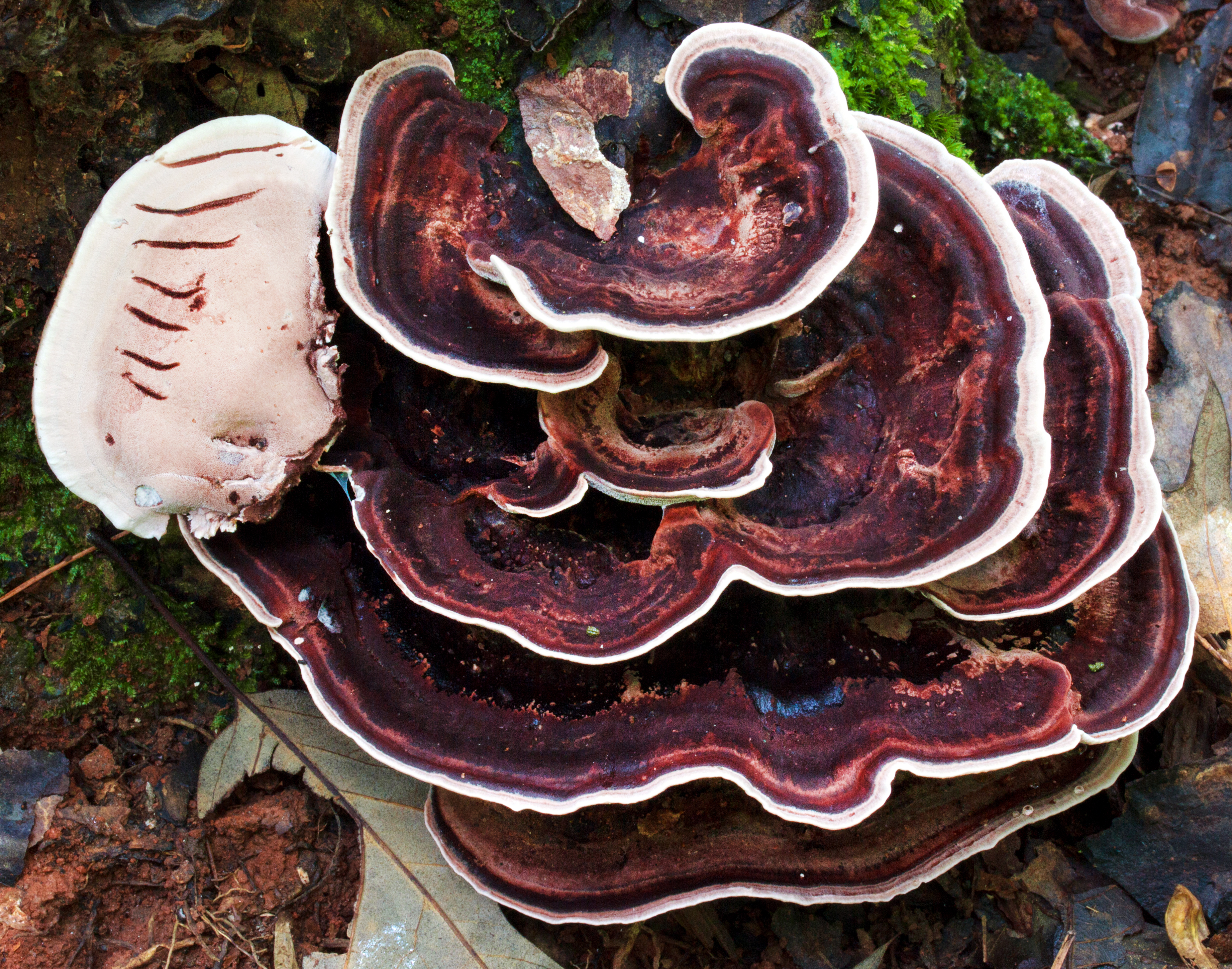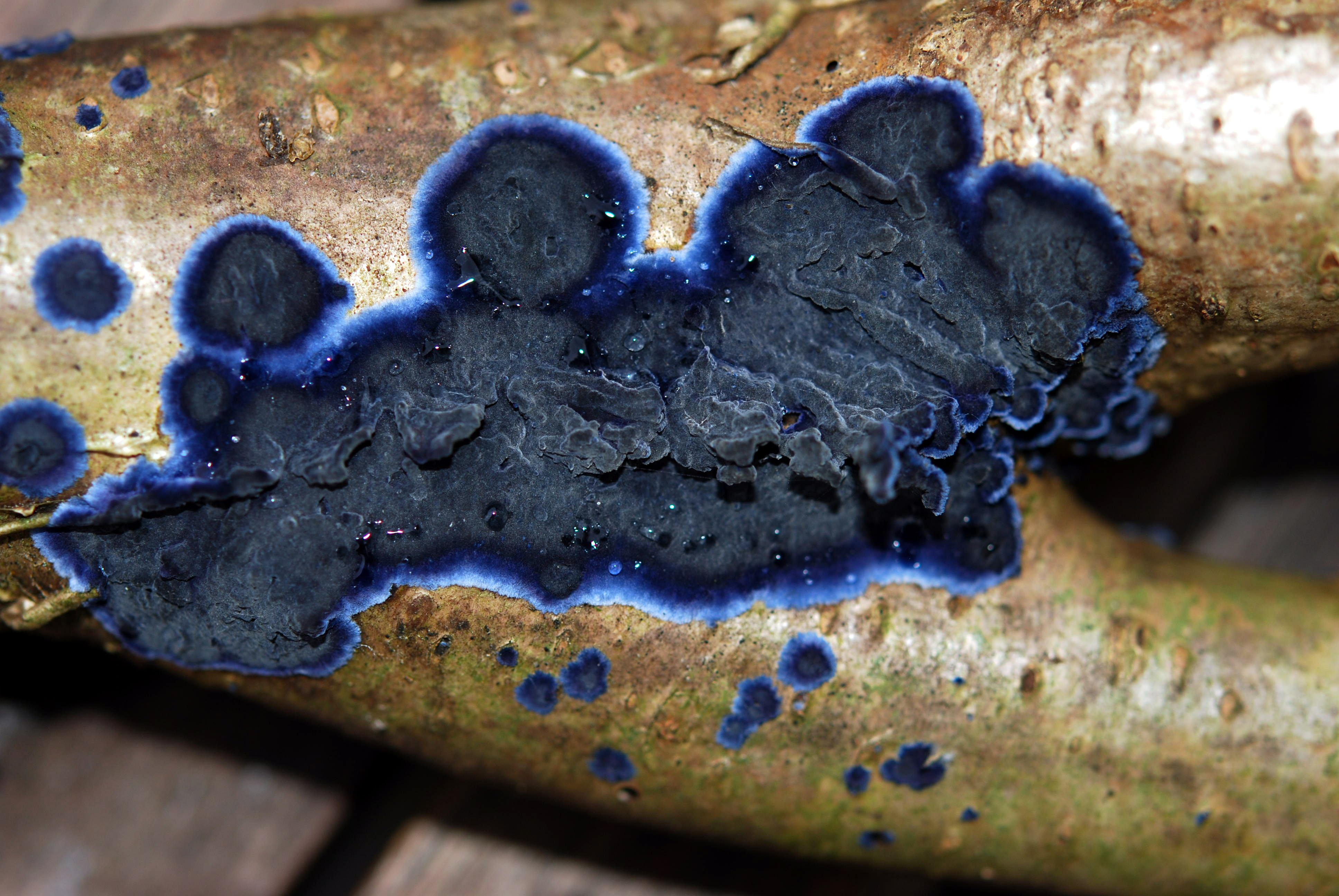|
Nigroporus
''Nigroporus'' is a genus of poroid fungi in the family Steccherinaceae. The genus was circumscribed by American mycologist William Alphonso Murrill in 1905. ''Nigroporus'' has a pantropical distribution. The genus name combines the Latin word ''niger'' ("black") with the Ancient Greek word ("pore"). Description The fruit bodies of ''Nigroporus'' fungi are annual to perennial. Their form ranges from pileate (with a cap) to crust-like. When a cap is present, it is scrupose (rough with very small hard points) to smooth, and sometimes with concentric zones. The colour is greyish-blue, vinaceous-brown to pink or violet. The pore surface has the same colours as the cap; pores are usually small and round to angular. The context is vinaceous brown to pink and purplish. The hyphal system is dimitic, meaning it contains both generative and skeletal hyphae. The generative hyphae have clamp connections; the skeletal hyphae are brownish, and thick-walled to solid. There are no ... [...More Info...] [...Related Items...] OR: [Wikipedia] [Google] [Baidu] |
Nigroporus Vinosus
''Nigroporus vinosus'' is a species of poroid fungus in the family Steccherinaceae, and the type species of the genus ''Nigroporus''. Its fruit bodies have brownish caps with tinges of purple or red. The cap underside has a pore surface the same colour as the cap, and minute pores. ''Nigroporus vinosus'' has a pantropical distribution. It has been recorded from Africa, North America, Central America, South America, Asia, and Oceania. It is a wood-decay fungus that causes a white rot. Taxonomy The fungus was first described scientifically by Miles Joseph Berkeley as ''Polyporus vinosus'' in 1852. The type was collected in Saint-Domingue by Augustus Sallé. Berkeley called the fungus "a very remarkable species, to which I can point out nothing closely allied." William Alphonso Murrill made it the type species of his newly created genus ''Nigroporus'' in 1905. He noted that the fungus was "easily recognized by its wine-coloured context." In the interim between Berkeley a ... [...More Info...] [...Related Items...] OR: [Wikipedia] [Google] [Baidu] |
Nigroporus Macroporus
''Nigroporus macroporus'' is a species of poroid fungus in the family Steccherinaceae. It was described as new to science in 2003 by mycologists Leif Ryvarden and Teresa Iturriaga. Found in Venezuela and Brazil, it is a wood-decay fungus that causes a white rot in the hardwood ''Dimorphandra macrostachya''. Description Fruit bodies of the fungus are bracket-like with a semicircular dark brown to black cap measuring up to wide, long, and thick. They have a leathery texture when fresh that becomes dry and woody in age. The dark brown pore surface comprises pores numbering 1–2 per millimetre, or fewer on decurrent parts where the pores get stretched out. The spores of ''N. macroporus'' are cylindrical, smooth and thin-walled, hyaline, and measure 5–6 by 1.7–2 µm The micrometre ( international spelling as used by the International Bureau of Weights and Measures; SI symbol: μm) or micrometer (American spelling), also commonly known as a micron, is a ... [...More Info...] [...Related Items...] OR: [Wikipedia] [Google] [Baidu] |
Steccherinaceae
The Steccherinaceae are a family of about 200 species of fungi in the order Polyporales. It includes crust-like, toothed, and poroid species that cause a white rot in dead wood. Taxonomy The family was circumscribed by Czech mycologist Erast Parmasto in 1968. Parmasto's original concept included species that are today classified in the Agaricales, Hymenochaetales, Polyporales, and Russulales. A large-scale molecular study published in 2012 by Otto Miettinen and colleagues redefined the limits of the Steccherinaceae to include most species of the poroid and hydnoid genera ''Antrodiella'', ''Junghuhnia'', and ''Steccherinum'', as well as members of 12 other hydnoid and poroid genera. These genera were traditionally classified in the families Phanerochaetaceae, Polyporaceae, and Meruliaceae. They commented: "we see the need for at least 30 monophyletic, morphologically distinguishable genera. These include no fewer than 15 new genera for both polypores and hydnoid fungi, and reviv ... [...More Info...] [...Related Items...] OR: [Wikipedia] [Google] [Baidu] |
Pileus (mycology)
The pileus is the technical name for the cap, or cap-like part, of a basidiocarp or ascocarp ( fungal fruiting body) that supports a spore-bearing surface, the hymenium.Moore-Landecker, E: "Fundamentals of the Fungi", page 560. Prentice Hall, 1972. The hymenium ( hymenophore) may consist of lamellae, tubes, or teeth, on the underside of the pileus. A pileus is characteristic of agarics, boletes, some polypores, tooth fungi, and some ascomycetes. Classification Pilei can be formed in various shapes, and the shapes can change over the course of the developmental cycle of a fungus. The most familiar pileus shape is hemispherical or ''convex.'' Convex pilei often continue to expand as they mature until they become flat. Many well-known species have a convex pileus, including the button mushroom, various '' Amanita'' species and boletes. Some, such as the parasol mushroom, have distinct bosses or umbos and are described as '' umbonate''. An umbo is a knobby protrusion at th ... [...More Info...] [...Related Items...] OR: [Wikipedia] [Google] [Baidu] |
Crust Fungus
The corticioid fungi are a group of fungi in the Basidiomycota typically having effused, smooth basidiocarps (fruit bodies) that are formed on the undersides of dead tree trunks or branches. They are sometimes colloquially called crust fungi or patch fungi. Originally such fungi were referred to the genus '' Corticium'' ("corticioid" means ''Corticium''-like) and subsequently to the family '' Corticiaceae'', but it is now known that all corticioid species are not necessarily closely related. The fact that they look similar is an example of convergent evolution. Since they are often studied as a group, it is convenient to retain the informal (non-taxonomic) name of "corticioid fungi" and this term is frequently used in research papersLarsson K-H, Larsson E, Koljalg U. (2004). High phylogenetic diversity among corticioid homobasidiomycetes. ''Mycological Research'' 108: 983–1002. and other texts. History The genus ''Corticium'' was established by Persoon in 1794 for fungi having s ... [...More Info...] [...Related Items...] OR: [Wikipedia] [Google] [Baidu] |
Trama (mycology)
In mycology, the term trama is used in two ways. In the broad sense, it is the inner, fleshy portion of a mushroom's basidiocarp, or fruit body. It is distinct from the outer layer of tissue, known as the pileipellis or cuticle, and from the spore-bearing tissue layer known as the hymenium. In essence, the trama is the tissue that is commonly referred to as the "flesh" of mushrooms and similar fungi.Largent D, Johnson D, Watling R. 1977. ''How to Identify Mushrooms to Genus III: Microscopic Features''. Arcata, CA: Mad River Press. . pp. 60–70. The second use is more specific, and refers to the "hymenophoral trama" that supports the hymenium. It is similarly interior, connective tissue, but it is more specifically the central layer of hyphae running from the underside of the mushroom cap to the lamella or gill, upon which the hymenium rests. Various types have been classified by their structure, including trametoid, cantharelloid, boletoid, and agaricoid, with agaricoid t ... [...More Info...] [...Related Items...] OR: [Wikipedia] [Google] [Baidu] |
Hypha
A hypha (; ) is a long, branching, filamentous structure of a fungus, oomycete, or actinobacterium. In most fungi, hyphae are the main mode of vegetative growth, and are collectively called a mycelium. Structure A hypha consists of one or more cells surrounded by a tubular cell wall. In most fungi, hyphae are divided into cells by internal cross-walls called "septa" (singular septum). Septa are usually perforated by pores large enough for ribosomes, mitochondria, and sometimes nuclei to flow between cells. The major structural polymer in fungal cell walls is typically chitin, in contrast to plants and oomycetes that have cellulosic cell walls. Some fungi have aseptate hyphae, meaning their hyphae are not partitioned by septa. Hyphae have an average diameter of 4–6 µm. Growth Hyphae grow at their tips. During tip growth, cell walls are extended by the external assembly and polymerization of cell wall components, and the internal production of new cell membran ... [...More Info...] [...Related Items...] OR: [Wikipedia] [Google] [Baidu] |
Fungi
A fungus (plural, : fungi or funguses) is any member of the group of Eukaryote, eukaryotic organisms that includes microorganisms such as yeasts and Mold (fungus), molds, as well as the more familiar mushrooms. These organisms are classified as a Kingdom (biology), kingdom, separately from the other eukaryotic kingdoms, which by one traditional classification include Plantae, Animalia, Protozoa, and Chromista. A characteristic that places fungi in a different kingdom from plants, bacteria, and some protists is chitin in their cell walls. Fungi, like animals, are heterotrophs; they acquire their food by absorbing dissolved molecules, typically by secreting digestive enzymes into their environment. Fungi do not photosynthesize. Growth is their means of motility, mobility, except for spores (a few of which are flagellated), which may travel through the air or water. Fungi are the principal decomposers in ecological systems. These and other differences place fungi in a single gro ... [...More Info...] [...Related Items...] OR: [Wikipedia] [Google] [Baidu] |
Annual Plant
An annual plant is a plant that completes its life cycle, from germination to the production of seeds, within one growing season, and then dies. The length of growing seasons and period in which they take place vary according to geographical location, and may not correspond to the four traditional seasonal divisions of the year. With respect to the traditional seasons, annual plants are generally categorized into summer annuals and winter annuals. Summer annuals germinate during spring or early summer and mature by autumn of the same year. Winter annuals germinate during the autumn and mature during the spring or summer of the following calendar year. One seed-to-seed life cycle for an annual plant can occur in as little as a month in some species, though most last several months. Oilseed rapa can go from seed-to-seed in about five weeks under a bank of fluorescent lamps. This style of growing is often used in classrooms for education. Many desert annuals are therophytes, b ... [...More Info...] [...Related Items...] OR: [Wikipedia] [Google] [Baidu] |




